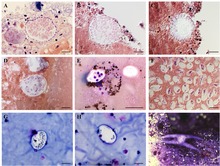Hemolivia
| Hemolivia | |
|---|---|
 |
|
| Hemolivia argantis (A–H) and Hemolivia stellata (I) in their invertebrate hosts | |
| Scientific classification | |
| Domain: | Eukaryota |
| (unranked): | SAR |
| (unranked): | Alveolata |
| Phylum: | Apicomplexa |
| Class: | Coccidia |
| Order: | Eucoccidiorida |
| Suborder: | Adeleorina |
| Family: | Karyolysidae |
| Genus: | Hemolivia |
| Species | |
Hemolivia mariae
Hemolivia mauritanica
Hemolivia stellata
Hemolivia (also spelled Haemolivia) is a genus of the phylum Apicomplexia.
This genus was described in 1990 by Petit et al.
The type species is Hemolivia stellata. Molecular data on H. stellata were provided in 2015 by Karadjian, Chavatte and Landau, from a 25-year-old archived smear of crushed tick (Amblyomma rotondatum).
Hepatozoon argantis Garnham, 1954 was reassigned to Hemolivia as Hemolivia argantis (Garnham, 1954) Karadjian, Chavatte and Landau, 2015.
The species in this genus are haemogregarines and infect exothermic vertebrates. They have erythrocytic gamogony, both erythrocytic and extra-erythrocytic merogony and cystogony. The definitive hosts are ixodid ticks.
Sporogony occurs in two phases. In the first phase conjugation and fertilization occur within the tick gut. This is followed by the formation of oocysts and the generation of sporokinetes. In the second phase the sporokinetes invade the body of the tick and give rise to sporocysts containing sporozoites infective to the vertebrate host.
The vertebrate host of this species is the cane toad (Bufo marinus). The invertebrate host is the tick Amblyomma rotondatum.
Toads become infected by ingesting infected ticks. The sporozoites are released from the sporocysts within the tick and penetrate the intestinal wall. Within the toad they replicate within the endothelial cells and erythrocytes. Liver cysts may form.
...
Wikipedia
